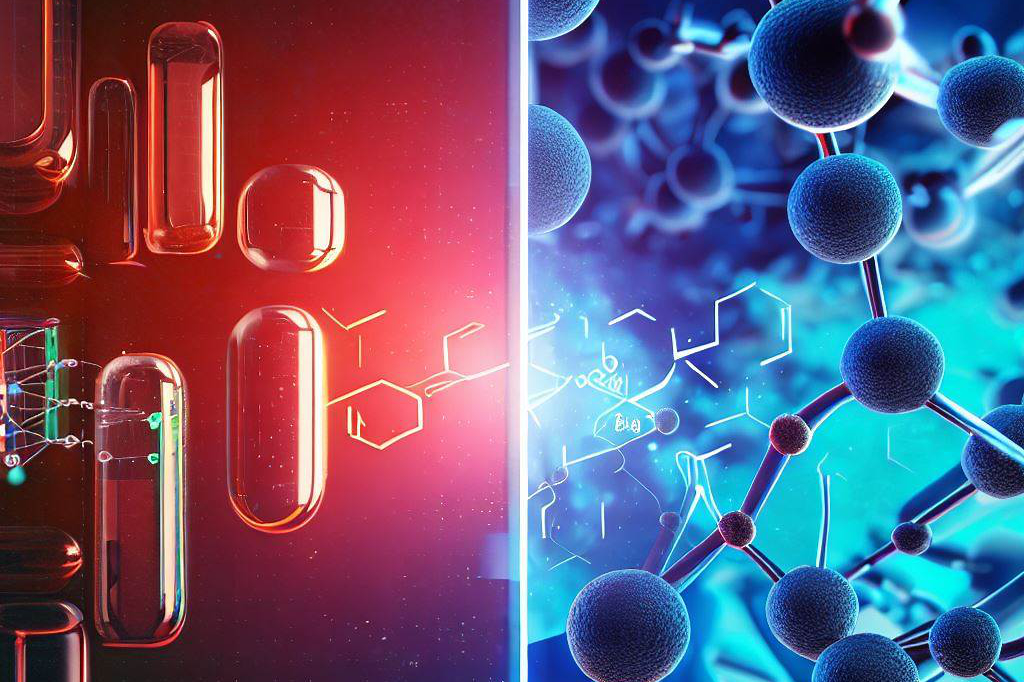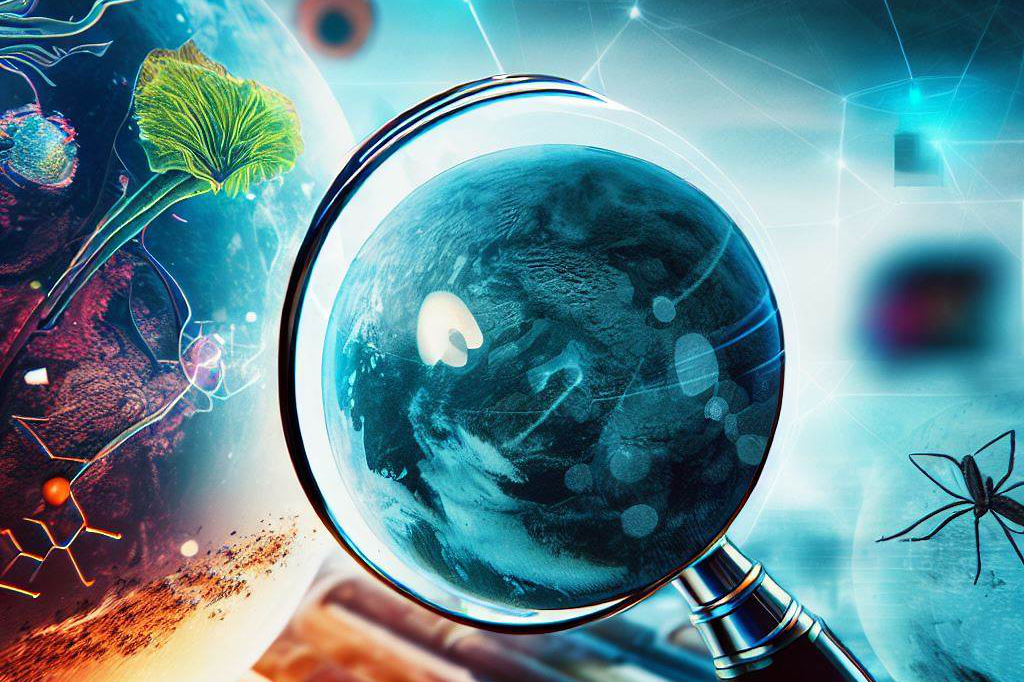The Search for Extraterrestrial Life
Are we alone in the universe?
This question has captivated the human imagination since ancient times. Today, with advances in technology and the discovery of billions of potentially habitable exoplanets, the search for extraterrestrial life has become a scientific endeavor.
However, detecting life beyond Earth is no easy task. One approach involves looking for biomarkers – substances that indicate the presence of life.

What are Biomarkers?
A biomarker is any measurable characteristic or molecule that provides information about a biological system or process. In the context of astrobiology, biomarkers are used to detect evidence of life beyond Earth. They can be organic or inorganic and may include molecules like amino acids, lipids, isotopes, minerals, and more.
Organic biomarkers are compounds that contain carbon atoms and are typically associated with living organisms. For example, amino acids are the building blocks of proteins, which play essential roles in all known forms of life on Earth.
Similarly, lipids are essential components of cell membranes found in living cells. Inorganic biomarkers include elements or compounds that could only be produced by biological processes – such as oxygen released by photosynthesis – or those that could not be produced by non-biological processes under certain conditions – such as isotopic ratios indicating biological fractionation.
Why Look for Biomarkers?
The detection of biomarkers would provide strong evidence for the existence of extraterrestrial life. In other words, if we find biomolecules on another planet or moon that cannot be explained by abiotic (non-living) processes alone, it is reasonable to conclude they were produced by living organisms.
Furthermore, biomarker detection can help us determine whether a particular environment is habitable – meaning it has conditions suitable to support life as we know it. For example, if we detect organic molecules on the surface of Mars, it suggests that there may be subsurface microbial life or that Mars once had a habitable environment.
Overall, biomarker detection is an essential tool in the search for extraterrestrial life. While it is not a foolproof method and has its limitations, it provides an exciting avenue for astrobiologists to explore new worlds and discover what might be hiding out there.
Types of Biomarkers

Organic Biomarkers: The Building Blocks of Life
Organic biomarkers are molecules that contain carbon and are essential to life as we know it. They can provide evidence that a planet or moon once had the necessary ingredients for life, or even that life currently exists there.
One well-known organic biomarker is amino acids, which are the building blocks of proteins. Lipids, which are important components of cell membranes, are another organic biomarker.
Other examples include nucleotides (the building blocks of DNA and RNA) and carbohydrates.
While organic biomarkers can be strong indicators of life, they can also be produced by non-biological processes.
For example, some amino acids have been found in meteorites and comets, suggesting that they may have formed through chemical reactions in space rather than being produced by living organisms. Nevertheless, the discovery of organic biomarkers on other planets or moons would still be an exciting development in our search for extraterrestrial life.
Inorganic Biomarkers: Clues to Environmental Conditions
Inorganic biomarkers refer to non-carbon-based molecules or elements that can provide clues about the environmental conditions on another planet or moon. For example, isotopes (variants of an element with different numbers of neutrons) can indicate whether water is present on a planet’s surface and what temperatures it has experienced in the past. Minerals can also serve as inorganic biomarkers.
Some minerals form under specific conditions that are only found on Earth when living organisms are present (such as stromatolites). If similar minerals were discovered on another planet or moon without known biological activity taking place there, it could suggest the presence of microbial life.
As with organic biomarkers, it’s important to consider non-biological explanations for the presence of inorganic biomarkers before making any conclusions about extraterrestrial life. However, the variety of inorganic biomarkers that can be detected and analyzed provides additional avenues for investigating the potential habitability of other worlds.
Combining Organic and Inorganic Biomarkers
One of the strengths of biomarker detection is that different types of biomarkers can be combined to provide more robust evidence for life. For example, if a planet or moon had both organic molecules and isotopes with unusual ratios, it would suggest that biological processes were at work.
By analyzing multiple types of biomarkers together, researchers can also learn more about how life might exist on other planets or moons. For instance, if amino acids were discovered on a planet with no known water source, it could suggest that life there has adapted to an entirely different type of environment than what we’re used to on Earth.
Techniques for Detecting Biomarkers

Mass Spectrometry: Analyzing the Mass and Charge of Molecules
One of the most widely used techniques for detecting biomarkers is mass spectrometry. This technique works by ionizing molecules and then analyzing them based on their mass and charge. By looking at the unique patterns in the resulting spectra, researchers can identify specific molecules, including biomarkers.
Mass spectrometry has been used to detect a wide range of biomarkers, including amino acids, lipids, and even complex organic molecules like nucleic acids. It has also been used to detect isotopic ratios that can provide clues about the environment in which these molecules were formed.
Raman Spectroscopy: Using Light Scattering to Identify Molecules
Another technique for detecting biomarkers is Raman spectroscopy. This technique works by shining a laser on a sample and analyzing the scattered light.
By looking at the unique patterns in the resulting spectra, researchers can identify specific molecules. Raman spectroscopy has several advantages over other techniques.
It requires very little preparation of samples, and it can be done remotely using instruments like rovers or landers. Additionally, Raman spectroscopy can be used to detect biomarkers even in very small quantities.
Fluorescence Spectroscopy: Measuring Fluorescent Emissions from Molecules
Fluorescence spectroscopy is another powerful tool for detecting biomarkers. This technique works by exciting molecules with light at a certain wavelength and then measuring their fluorescent emissions at a different wavelength. Fluorescence spectroscopy has several advantages over other techniques as well.
It allows for very sensitive detection of specific molecules, even in complex mixtures of other compounds. Additionally, fluorescence spectroscopy can be used to detect changes in biological systems over time, making it useful not only for detecting biomarkers, but also for studying their functions and interactions.
There are several techniques available for detecting biomarkers, each with its own strengths and weaknesses. By combining these techniques and exploring new ones, researchers can continue to make progress towards the goal of identifying extraterrestrial life.
Examples of Potential Biomarkers for Extraterrestrial Life

Methane on Mars: The Red Planet’s Mysteries
Methane gas is one of the most commonly cited biomarkers for extraterrestrial life detection, and it has been a very intriguing target on Mars. One reason methane is a potential biomarker is that it can be produced by certain types of microbes, which means that if there were large concentrations of methane on Mars, there could (theoretically) be living organisms producing it.
The first hints of methane came from observations made by Earth-based telescopes in the early 2000s. Later on, NASA’s Curiosity rover detected small amounts of methane in the Martian atmosphere during its mission in 2013.
While these findings are not conclusive evidence for life on Mars, they do suggest that some kind of methane-producing process may be happening below the surface or even within rock formations. Future missions will potentially seek to find more definitive evidence for or against this hypothesis.
Phosphine in Venus’ Atmosphere: A Mystery Waiting to Be Solved
Phosphine was recently discovered in the atmosphere of Venus by researchers using ground-based telescopes and data from previous spacecraft missions. This discovery raised a lot of excitement because phosphine is a gas that should not exist in significant quantities under normal planetary conditions; instead, it would have to be produced by some form of life or other unknown chemical reaction. The discovery was made using spectroscopy techniques from Earth-based observatories.
Even though this gas could point to signs of life on Venus, scientists are careful not to jump to conclusions too quickly since many other processes could produce phosphine as well. Therefore, further research will be needed before we can determine whether or not phosphine really is a biomarker for extraterrestrial life.
Glycine Found In Comets: Life’s Building Blocks
Glycine is an amino acid that is a key building block of life as we know it. It was first discovered in a comet by NASA’s Stardust mission in 2006. Scientists believe that comets may have delivered important biomolecules such as glycine to Earth early in its history, which could have played a crucial role in the origins of life on our planet.
The discovery of glycine on comets is significant because it suggests that the same building blocks for life might exist elsewhere in our solar system or even beyond it. In recent years, there has been increased interest in exploring comets and other small bodies in our solar system to search for more complex organic molecules and potential signs of extraterrestrial life.
Challenges in Detecting Biomarkers

Contamination from Earth: The Precarious Search for Extraterrestrial Life
One of the biggest challenges facing astrobiologists today is contamination from Earth. This is because any equipment or spacecraft that we send to other planets could potentially carry microbial life with it.
Thus, if we find microbial life on another planet, it is possible that it actually originated from Earth rather than from that planet. For this reason, great care must be taken to ensure that all equipment and spacecraft are thoroughly sterilized before they are sent on a mission.
Low Abundance of Biomarkers: Finding Needles in Haystacks
Another challenge facing astrobiologists is the low abundance of biomarkers in most extraterrestrial environments. This means that even if there is life on another planet, it may be very difficult to detect its presence using current technologies.
For example, if we were to look for amino acids on Mars using mass spectrometry, we might only find a few molecules per kilogram of rock or soil sample. This makes the search for extraterrestrial life like looking for a needle in a haystack.
Different Environmental Conditions on Other Planets: Life as We Don’t Know It
One of the biggest challenges facing astrobiologists is the fact that life on other planets may look very different from life on Earth. For example, many scientists believe that Saturn’s moon Titan could harbor methane-based life forms rather than carbon-based ones like those found on Earth. Similarly, some scientists speculate that there could be silicon-based life forms living deep beneath the surface of Venus or Mars.
If this is true, then our current methods for detecting biomarkers may not be sufficient to detect such life forms, and we will need new methods and instruments to do so. While detecting biomarkers is a promising avenue for detecting extraterrestrial life, it is not without its challenges.
Contamination from Earth, a low abundance of biomarkers, and different environmental conditions on other planets all present significant obstacles to finding life beyond our own planet. Nonetheless, the search for extraterrestrial life remains one of the most exciting and important scientific endeavors of our time.
Future Directions for Biomarker Detection

Development of New Instruments and Techniques
The search for extraterrestrial life has always been a fascinating subject, and with advances in technology, we are getting closer to finding it. The discovery of new biomarkers requires the development of new instruments and techniques that can detect molecules at extremely low concentrations. Mass spectrometry, Raman spectroscopy, and fluorescence spectroscopy are some of the techniques currently used to detect biomarkers.
However, these methods have limitations, such as sensitivity and accuracy. Therefore, scientists are continuously developing new instruments that can surpass these limitations.
One example is the European Space Agency’s Rosalind Franklin (formerly “ExoMars”) rover mission, which will carry an instrument called MOMA (Mars Organic Molecule Analyzer), capable of detecting organic molecules with high accuracy. Another example is the use of traditional telescopes alongside advanced adaptive optics that correct distortions caused by Earth’s atmosphere to allow for more precise detection of specific molecules in exoplanet atmospheres.
Exploration of More Diverse Environments
Most searches for extraterrestrial life have been focused on planets similar to Earth in terms of environmental conditions like temperature range or atmosphere composition. However, in recent years scientists have begun exploring more diverse environments, such as subsurface oceans on icy moons like Europa or Enceladus.
These environments may offer unique opportunities to find biomarkers from microbial life forms adapted to extreme conditions such as high radiation levels or low temperatures. For instance, researchers discovered methane plumes erupting from Enceladus’ south pole plumes using data collected by NASA’s Cassini spacecraft across several flybys before its fiery descent into Saturn’s atmosphere.
The search for biomarkers must also involve investigations beyond our Solar System using telescopes like the Hubble Space Telescope or James Webb Space Telescope (JWST).
JWST will help us understand the chemical composition of exoplanet atmospheres and potentially detect biomarkers that are not found on Earth.
The search for extraterrestrial life is ongoing, and it has captured the imagination of scientists and the general public alike. The detection of biomarkers is one way to search for life beyond our planet, and as technology advances, so does our ability to detect these molecules with greater precision.
The development of new instruments and techniques like MOMA or JWST offers exciting opportunities to discover new biomarkers in diverse, previously unexplored environments. As we continue searching for life beyond our planet, it’s essential to remain open-minded about what we may find and what form it might take – whether microbial or intelligent.
Who knows? Perhaps someday soon, we will finally have concrete proof that we are not alone in the universe.
TL;DR – FAQs
What are biomarkers?
Biomarkers are any measurable characteristic or molecule that provides information about a biological system or process. In the context of astrobiology, biomarkers are used to detect evidence of life beyond Earth. They can be organic or inorganic and may include molecules like amino acids, lipids, isotopes, minerals, and more.
Why do we look for biomarkers?
The detection of biomarkers would provide strong evidence for the existence of extraterrestrial life. If we find biomolecules on another planet or moon that cannot be explained by abiotic (non-living) processes alone, it is reasonable to conclude they were produced by living organisms.
What are some examples of organic and inorganic biomarkers?
Organic biomarkers are compounds that contain carbon atoms and are typically associated with living organisms. Examples include amino acids, lipids, nucleotides, and carbohydrates. Inorganic biomarkers include elements or compounds that could only be produced by biological processes or those that could not be produced by non-biological processes under certain conditions.
What techniques are used for detecting biomarkers?
Techniques for detecting biomarkers include mass spectrometry, Raman spectroscopy, and fluorescence spectroscopy. These techniques allow for the identification and analysis of specific molecules, including biomarkers.
What are some examples of potential biomarkers for extraterrestrial life?
Examples of potential biomarkers for extraterrestrial life include methane on Mars, phosphine in Venus’ atmosphere, and glycine found in comets.
What are the challenges in detecting biomarkers?
Challenges in detecting biomarkers include contamination from Earth, low abundance of biomarkers, and different environmental conditions on other planets.
What are future directions for biomarker detection?
Future directions for biomarker detection include the development of new instruments and techniques, and the exploration of more diverse environments. For example, the European Space Agency’s Rosalind Franklin rover mission will carry an instrument capable of detecting organic molecules with high accuracy, and scientists are beginning to explore environments such as subsurface oceans on icy moons like Europa or Enceladus.

C M, a seasoned editor, journalist, and consultant, is deeply fascinated by the convergence of technology, space, and the future of humanity.
With a particular interest in transhumanity, futurology, and the philosophical and ethical dimensions of these domains, C M serves as the lead contributor to SpaceSpotlight and TranscendSphere.
When not penning insightful articles on these rapidly evolving fields, C M indulges in their love for podcasts and books, proudly embracing their status as a ‘Happy Nerd Extraordinaire!’



